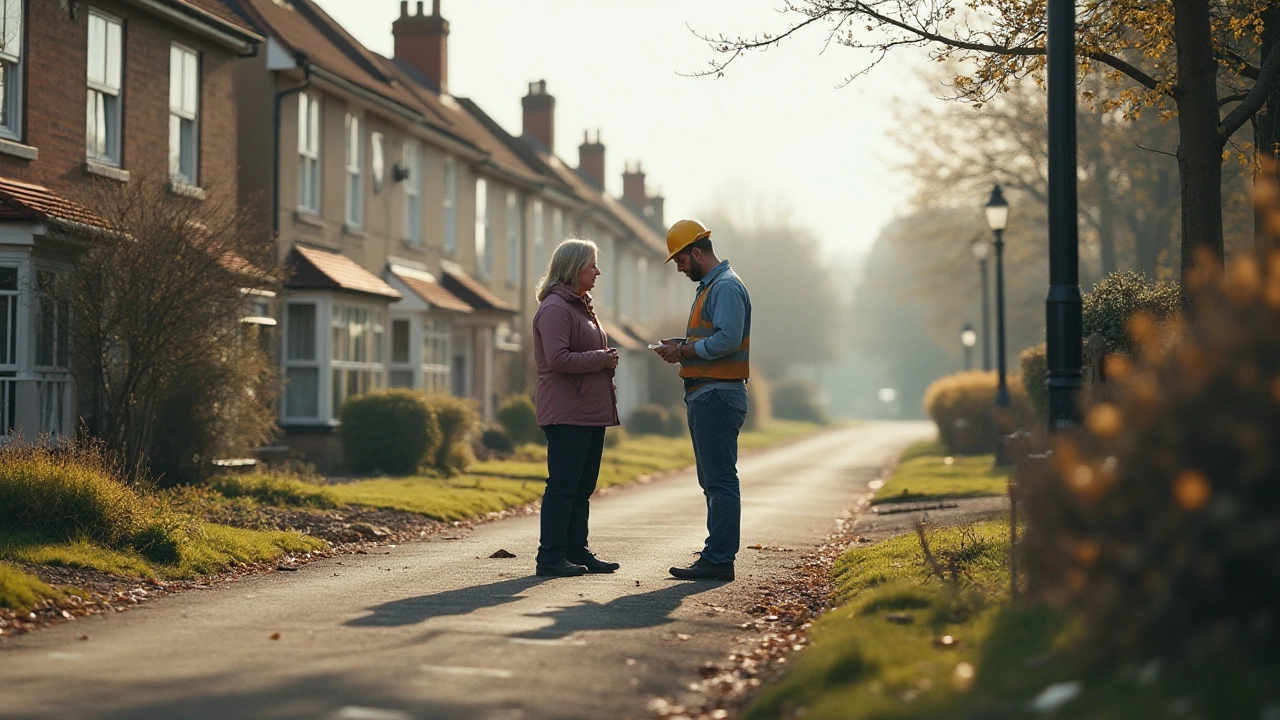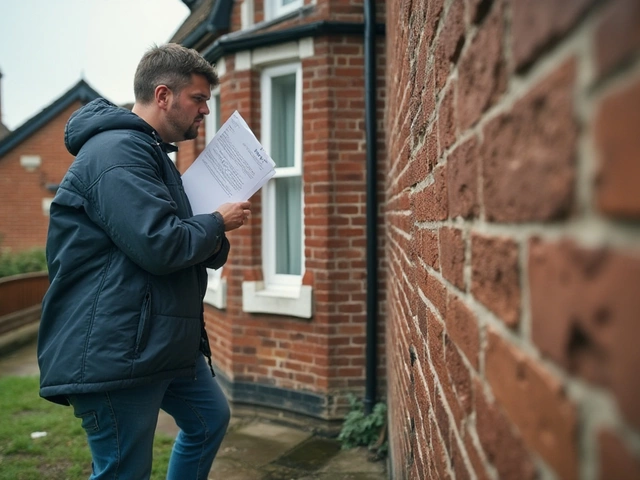
House foundations are often considered the bedrock of a home’s safety and stability. But what happens when this crucial element starts to give way? Foundation problems can gradually transform from minor nuisances into severe threats, with the potential of compromising your entire structure.
It's not just about a few cracks in the wall or sticking doors. We're talking about profound impacts that could lead to dire outcomes. The key lies in recognizing these issues early and addressing them head-on. This article seeks to unravel the complexities surrounding foundation troubles and their impact on your house's safety. Observe, understand, and act—because when it comes to your home, there’s no room for error.
- Recognizing Foundation Problems
- Causes of Foundation Weakness
- How Foundation Issues Lead to House Collapse
- Warning Signs of Structural Distress
- Preventive Measures for Homeowners
- When to Call in the Professionals
Recognizing Foundation Problems
One might think a house is a static construct, unwavering and unyielding. But in reality, foundations are ever responding to their environment—shifting soil, fluctuating moisture levels, or simply the passage of time. Knowing when these factors have begun to compromise your home's foundation is crucial. The first step is to stay vigilant and observant to any peculiar changes. Homeowners should regularly inspect both the exterior and interior of their homes. Look for cracks, even if they're hairline, which tend to appear around window frames, doorways, or the corners of walls. These cracks might seem inconsequential but can often serve as red flags for deeper, more insidious problems hiding beneath.
On top of that, a staggering tell-tale sign of foundation distress is uneven floors. Walk around your home, and if you notice any slopes or the feeling of walking downhill, this might indicate shifting within the foundation. Interestingly, doors and windows that previously operated smoothly and now jam or stick can hint at structural issues below. These signs suggest that the frame is bending, a consequence of instability in the ground below. Additionally, expansion or contraction in the foundation is frequently a reaction to extreme climate conditions, which can exacerbate these problems.
For many, the idea of checking for plumbing issues probably doesn't come up initially when evaluating foundation problems. Yet, leaky pipes beneath your home can wash away soil and lead to erosion, further destabilizing your foundation. Such problems underscore the importance of holistic home maintenance, where everything from well-functioning drains to adequate guttering plays a role in preserving foundation integrity. A proactive inspection model, encompassing both obvious and subtle signals, is the key to preventing minor inconveniences from snowballing into substantial concerns.
Inspection should not just be a surface activity. Setting aside a few afternoons a year to delve into these investigations can save substantial resources and ensure peace of mind. Homeowners are advised to maintain a checklist of possible warning signs. Keeping an eye on these factors while being mindful of your property’s history and specific exposure to natural elements lays the groundwork for early detection of possible foundation issues. Consistency in these efforts often pays off, turning curveballs into predictable routines rather than emergency salvations.
In the words of David W. R. Morgan, a well-known structural engineer, "Recognizing the omens early is not just good for your home, but crucial for safety. Inculcate an investigative mindset towards your house; it’s much more than bricks and mortar—it’s an ecosystem of interlocking parts." House inspections should be as regular as those we take for our own health. They protect not just our assets but our dwellings' ultimate structural integrity. The smallest sign can indicate foundational weakness, and early recognition is the virtue of apprise in foundation repair.
Causes of Foundation Weakness
The vitality of a house rests on its foundation, yet this crucial component can suffer due to several factors that might not be immediately apparent to an average observer. One of the prevalent causes impacting foundation repair needs is soil type. Soil bodies naturally differ in their properties, and certain types like clay can be particularly problematic. Clay soil expands significantly when wet and contracts as it dries, wreaking havoc on the foundation by causing it to shift or crack. Additionally, poor drainage systems contribute heavily to foundation issues. When water is not efficiently redirected away from the house, it pools around the base, saturating the soil and imposing undue stress on the foundation.
Another critical factor involves settlement. Natural settling of the ground beneath the house can impact the strength of the foundation over time. This occurs as layers of soil press more tightly due to the weight of the building and external forces. Improperly compacted fill soil used during construction can expedite this settlement process, leading to unpredictable changes that challenge the foundation's stability. Human activities such as nearby construction work or the removal of mature trees could also initiate foundation weakness. The roots of these trees often act as a natural barrier that stabilizes soil moisture levels, and their removal can inadvertently lead to a detrimental increase in soil movement.
Weather plays an unsung role in the battle against structural issues. Areas that experience extreme climate fluctuations, such as harsh winters with subsequent rapid thaws, expose houses to cycles of freezing and thawing. These conditions cause soil expansion and contraction, impacting foundation integrity. Earthquakes, albeit less frequent, pose a significant threat, unleashing forces that can catastrophically disturb the structural equilibrium of a house. Finally, poor construction practices, such as using substandard materials or laying a shallow foundation, can severely compromise a building's longevity. Regularly inspecting your home and promptly tending to early warning signs can help mitigate these risks and protect your investment.

How Foundation Issues Lead to House Collapse
It's a chilling thought, imagining your beloved home teetering on the brink of collapse due to unseen problems beneath the surface. The silent threat lies within the foundation—the very underpinning that keeps the house standing tall. But how does a seemingly small crack or a slight shift escalate into something catastrophic? Let's delve deeper into this feared scenario.
A foundation's main job is to evenly distribute the weight of the house across the ground, maintaining stability and balance. When this vital foundation is compromised, structural issues arise. Moisture, soil shifts, and neglect are common culprits that gnaw away at a foundation's integrity over time. When soil expands and contracts, it causes shifts, creating undue stress on the foundation and, by extension, the house. These movements, though minute at first, may lead to significant misalignments within the home. Windows may stop closing properly, or floors could begin to slope noticeably. Over time, these signs of distress amplify, and without intervention, they can lead to literal structural failure.
Consider the tale of a building in Dallas, Texas that suffered a sudden collapse a few years back. Upon investigation, it was revealed that neglect of small foundation cracks over several years, coupled with persistent water drainage issues, set the stage for weakening the structure. It was a sobering reminder that foundation problems, though not always visible, pose very real threats to building safety. As the saying goes, 'out of sight, out of mind' can be a dangerous approach when it concerns your home's foundation. As a preventive step, regular checks and thorough inspections are recommended, especially if you reside in areas known for their unstable soil or extreme weather conditions.
Even simple actions like poor landscape management can contribute significantly over time. Trees planted too close to the house withdraw moisture from the soil, leading to uneven ground shrinkage. Meanwhile, improperly directed downspout and gutter systems allow water to pool around the foundation, causing soil to wash away when it rains heavily. These create pressure points, which could eventually lead to the house settling unevenly. The resulting stress points are prime areas for cracks to develop and propagate through the structure, potentially leading to catastrophic outcomes.
According to Professor John Burland, a geotechnical engineer, "Most foundation failures could be avoided by proper inspection and timely intervention. It is crucial to recognise the first signs of distress and act swiftly."His words highlight the importance of being proactive when it comes to foundation repair, as waiting too long drastically increases the chances of severe issues. Ignoring subtle signs like hairline cracks can, over time, compromise an entire section of the home's foundation.
As daunting as it sounds, there's a silver lining. Technology in modern construction is such that most foundation issues can be fixed if caught in time. Techniques such as underpinning, which involves strengthening your existing foundation, are available and can effectively restore structural integrity. Still, it often falls upon the homeowner to initiate inspection and repairs. To prevent the risk of a house collapsing due to foundation problems, it's prudent to invest in periodic professional assessments. After all, safeguarding your home is not just about maintaining its market value; it's about ensuring the safety and security of those within its walls.
Warning Signs of Structural Distress
Every house tells a story through its walls, floors, and structures, and when there are whispers of damage, it’s wise to listen. One of the telltale signs of potential house collapse due to foundation issues is the presence of increasingly visible cracks in walls and ceilings. These aren’t just the quaint lines that add character to an old home; these are the jagged, sometimes widening cracks that manifest when things are seriously amiss. Such fissures often start small and expand over time, signaling that the earth beneath may be shifting, causing your home’s base to gradually detach.
Doors and windows becoming more difficult to open and close is another sign. It may seem benign at first – who hasn't struggled a bit with a stubborn door? But when these issues persist or worsen, they indicate the possibility of misalignment caused by a weakening foundation. As the base of a house shifts, it throws off balance the previously snugly fit doors and windows. Look out for instances where doors swing open by themselves or refuse to latch properly, as these can be evidence of underlying structural strain.
Your floors might have something to say, too. Have you ever noticed slopes or dips where there ought to be flat surfaces? Undulating floors can be an ominous omen of substructure distress. Similar to a shifty doorknob, a slope in your flooring means the foundation may not be distributing your home's weight evenly anymore. Over time, this uneven pressure can lead to significant and sometimes irreversible damage. Including problems with floorboards separating or tiling cracking unexpectedly.
Outside, your chimney might seem independent, but it’s actually an integral part of your home's structure. Leaning chimneys or visible gaps between the chimney and the house walls deserve immediate attention. Notably, a chimney start to part ways with the house structure is a sign of foundation problems that should never be ignored. It's a precarious sign of shifting balances that could spiral if left untouched. Engaging with these unsightly developments can shield your house from future peril.
Sudden increases in pest infestation may also signal foundation trouble. Small openings in walls, floors, and other crawl spaces create ingress points for unwanted critters. This is not only a nuisance but often speaks to the deeper issue of structural gaps where there should be none. It’s these crevices that tell the truer tale – your house might be silently falling apart unless corrective actions are swiftly deployed.
“A house is only as strong as its foundation,” is an old saying often recalled by repair experts. It’s a sentiment that underpins the very essence of structural integrity.
Yet, sometimes it's the things you don’t see—underneath the house—like bulging walls or uneven soil around the exterior, which can denote serious underpinning disarray. This clandestine turmoil manifests through changes in your home’s equilibrium. Keep an eye on these vulnerabilities and consult professionals for thorough inspections and advice. Remember, foundation health is not just about keeping up appearances; it’s the unsung hero of your treasure trove, your home.

Preventive Measures for Homeowners
When it comes to making sure your home's foundation stands the test of time, taking preventative steps is the best way to avoid costly repairs and potential structural damage. A proactive approach can significantly reduce the risk of your home suffering due to structural issues or even collapsing. One of the very first things a homeowner can do is routinely inspect their property for early signs of trouble. Being observant about small changes, such as uneven floors or newly formed cracks, helps catch problems before they escalate into serious foundation damage.
Another important consideration for protecting your foundation involves the management of soil moisture levels around your home. The expansion and contraction of soil due to excessive moisture fluctuation can exert unnecessary pressure on foundation walls. To maintain stability, install proper drainage systems along with well-sized gutters and downspouts. These prevent water from pooling at the base of your house. Landscaping choices also play a role in safeguarding your foundation. Plant trees far from the house and choose bushes and shrubs that require minimal watering to diminish root interference and reduce the amount of soil water absorption next to the house.
Regular testing of soil conditions and keeping foundation records is beneficial for understanding the historical impact of local weather and seasonal changes on your property's groundwork. This knowledge assists in making informed decisions about foundational care. Some homeowners employ professional services such as foundation specialists to conduct regular inspections.
"Foundation damage is a homeowner's nightmare, yet preventable through vigilance and timely action," emphasizes Richard Olsen, an experienced structural engineer.Not overlooking small repairs is critical, as they could point to bigger problems. Using concrete patching for minor floor cracks or resealing gaps can prevent these minor issues from worsening.
It's prudent to keep track of maintenance activities and document minor issues with photographs and notes. Homeowners are often unaware of the power of documentation, yet it becomes an invaluable asset when engaging a professional. Preventive tips also include ensuring your foundation remains visible and unobstructed by dense vegetation. In analyzing data from several studies, proper foundation visibility helped reduce annual repair costs by a measurable percentage. Keeping an eye on common household indicators such as door alignment, window function, and any shifting furniture, can enhance the detection of gradual shifts as well. Consulting with a structural engineer during the construction phase or major renovations bolsters confidence in the property's endurance, offering tailored advice specific to your local environment.
When to Call in the Professionals
At some point, every homeowner grapples with maintenance issues, but determining the right time to bring in a professional for foundation repair can be a game-changer. The signs might start subtly—a small crack here, a jammed window there—but it's crucial to discern when these minor issues are symptomatic of more significant, underlying problems. Foundations reflect the strength and longevity of a home. While seasonal changes and normal settling might cause some natural shifts, the time to act swiftly is when these signs persist or worsen without plausible physical reasons.
Think about factors like water damage, which can quickly expedite foundation issues. Water once welcomed by gardens can stealthily sip into the soil beneath the house, causing it to swell, contract, and disrupt the entire structure. In fact, the Engineering News-Record noted in a 2023 study that over 60% of structural failures in residential buildings involved improper water management. Therefore, if you notice persistent dampness in your basement or substantial water pooling near the foundation, it's time to reach for the phone. Similarly, significant horizontal cracks or gaps larger than 5 millimeters should definitely be on your watchlist, as these indicate stress beyond typical wear.
"Cracks in the foundation are like a window into the health of your entire structure. Ignoring them is like ignoring smoke signals," advises Marcus Taylor, a seasoned structural engineer with over 20 years of experience.
Beyond these surface symptoms, there’s the unpredictable behavior of the house itself. Have you felt as though your floors have become horizontal roller coasters, dipping inexplicably in places that were once solid? Or maybe you've noticed that dining table leaning just so, without anyone having moved it? Such changes, if not initially part of your home's quirky charm, suggest deeper shifts in your foundation. This is when expert evaluation trumps DIY fixes. Underpinning, for instance, is a technique that involves extending or modulating the supporting depths of your foundation, and is best left to professionals who have mastered the art.
For those intrigued by numbers, a study in 2022 by the International Association of Certified Home Inspectors found that nearly 85% of foundation structural issues stem from improper original construction practices or inadequate preparatory groundwork. This places an even greater emphasis on the importance of seeking professional help sooner rather than later. Remember, peace of mind comes not from guessing what hides beneath your floors but from knowing it’s sound. The earlier you address potential red flags with a professional's insight, the lower the risk of facing a hefty repair bill or the threat of a house collapse.
Ultimately, the difference lies in swift action versus prolonged procrastination. For the structurally savvy homeowner, this isn’t just about saving a few dollars—it’s about preserving what could be, in many ways, the greatest investment of a lifetime: your home.




